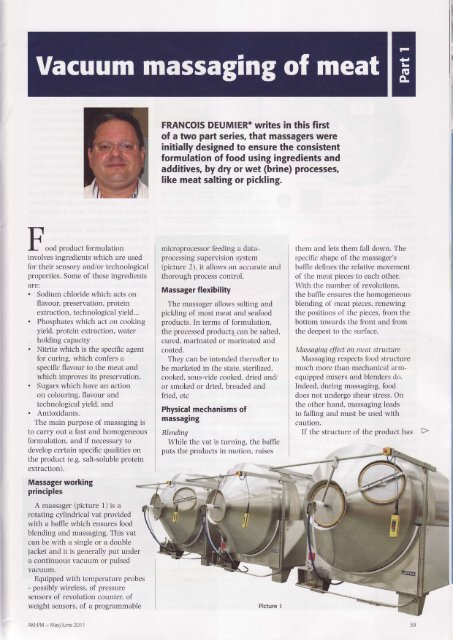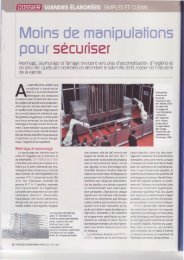FRANCOIS DEUMIER* writes in this first of a two part series ... - Lutetia
FRANCOIS DEUMIER* writes in this first of a two part series ... - Lutetia
FRANCOIS DEUMIER* writes in this first of a two part series ... - Lutetia
Create successful ePaper yourself
Turn your PDF publications into a flip-book with our unique Google optimized e-Paper software.
<strong>FRANCOIS</strong> <strong>DEUMIER*</strong> <strong>writes</strong> <strong>in</strong> <strong>this</strong> <strong>first</strong><br />
<strong>of</strong> a <strong>two</strong> <strong>part</strong> <strong>series</strong>, that massagers were<br />
<strong>in</strong>itially designed to ensure the consistent<br />
formulation <strong>of</strong> food us<strong>in</strong>g <strong>in</strong>gredients and<br />
additive+ by dry or wet (bdne) processes,<br />
like meat salt<strong>in</strong>g or pickl<strong>in</strong>g.<br />
ood product formulation<br />
<strong>in</strong>volves <strong>in</strong>gredients which are used<br />
for their sensory and/or technological<br />
properties. Some <strong>of</strong> these <strong>in</strong>gredients<br />
are:<br />
. Sodium chloride which acts on<br />
flavour, preservation, prote<strong>in</strong><br />
extraction, technological yield...<br />
. Phosphates which act on cook<strong>in</strong>g<br />
yield, prote<strong>in</strong> extraction, water<br />
hold<strong>in</strong>g capacity<br />
. Nitrite which is the specilic agent<br />
for cur<strong>in</strong>g, which confers a<br />
specific flavour to the meat and<br />
which improves its preservation.<br />
. Sugars which have an action<br />
on colour<strong>in</strong>g, flavour and<br />
technological yield, and<br />
. Antioxidants.<br />
The ma<strong>in</strong> purpose <strong>of</strong> massag<strong>in</strong>g is<br />
to carry out a fast and homogeneous<br />
formulation, and if necessary to<br />
develop certa<strong>in</strong> specific qualities on<br />
the product (e.g. salt-soluble prote<strong>in</strong><br />
extraction).<br />
Massager work<strong>in</strong>g<br />
pr<strong>in</strong>ciples<br />
A massager (picture 1) is a<br />
rotat<strong>in</strong>g cyl<strong>in</strong>drical vat provided<br />
with a baffle which ensures food<br />
blend<strong>in</strong>g and massag<strong>in</strong>g. This vat<br />
can be with a s<strong>in</strong>gle or a double<br />
jacket and it is generally put under<br />
a cont<strong>in</strong>uous vacuum or pulsed<br />
vacuum.<br />
Equipped with temperature probes<br />
- possibly wireless, <strong>of</strong> pressure<br />
sensors <strong>of</strong> revolution counter, <strong>of</strong><br />
weight sensors, <strong>of</strong> a programmable<br />
microprocessor feed<strong>in</strong>g a dataprocess<strong>in</strong>g<br />
supervision system<br />
(picture 2), it allows an accurate and<br />
thorough process control.<br />
Massager flexibility<br />
The massager allows salt<strong>in</strong>g and<br />
pickl<strong>in</strong>g <strong>of</strong> most meat and seafood<br />
products. In terms <strong>of</strong> formulation,<br />
the processed productq can be salted,<br />
cured, mar<strong>in</strong>ated or mar<strong>in</strong>ated and<br />
coated.<br />
They can be <strong>in</strong>tended thereafter to<br />
be marketed <strong>in</strong> the state. sterilized.<br />
cooked, sous-vide cooked, dried and/<br />
or smoked or dried, breaded and<br />
fried, etc<br />
Physical mechanisms <strong>of</strong><br />
massag<strong>in</strong>g<br />
Blendrng<br />
While the vat is turn<strong>in</strong>g, the baffle<br />
puts the products <strong>in</strong> motion, raises<br />
them and lets them fall down. The<br />
specilic shape <strong>of</strong> the massager's<br />
baffle def<strong>in</strong>es the relative movement<br />
<strong>of</strong> the meat pieces to each other.<br />
With the number <strong>of</strong> revolutions,<br />
the baffle ensures the homogeneous<br />
blend<strong>in</strong>g <strong>of</strong> meat pieces, renew<strong>in</strong>g<br />
the positions <strong>of</strong> the pieces, from the<br />
bottom towards the front and from<br />
the deepest to the surface.<br />
Massag<strong>in</strong>g ffict on meat structure<br />
Massag<strong>in</strong>g respects food structure<br />
much more than mechanical armequipped<br />
mixers and blenders do.<br />
Indeed, dur<strong>in</strong>g massag<strong>in</strong>g, food<br />
does not undergo shear stress. On<br />
the other hand, massag<strong>in</strong>g leads<br />
to fall<strong>in</strong>g and must be used with<br />
caution.<br />
If the structure <strong>of</strong> the product has<br />
AM:PM - May/une 201 l
Picture 2<br />
MALAXEUR 1<br />
2l mbar<br />
0 mbar<br />
{ to be protected, we should advise to<br />
turn slowly and to limit the number<br />
<strong>of</strong> turns. Thus, one will rather<br />
recommend 1000 to 1800 turns for<br />
a superior ham aga<strong>in</strong>st 4000 for a<br />
basic high-yield ham, <strong>in</strong> the section<br />
<strong>of</strong> which the muscle fibre will not be<br />
even recognizable any more. Vacuum<br />
also makes meat denser dur<strong>in</strong>g<br />
massag<strong>in</strong>g, which helps mechanical<br />
work,<br />
For the most fragile products, it<br />
is possible to work with a pendular<br />
mode massag<strong>in</strong>g by mak<strong>in</strong>g cycles<br />
<strong>of</strong> 75o/<strong>of</strong> a turn towards and<br />
ttaen 75o/<strong>of</strong> a turn forwards, thus<br />
prevent<strong>in</strong>g the product from fall<strong>in</strong>g.<br />
Mass transfers dur<strong>in</strong>g massag<strong>in</strong>g<br />
Diffusion mechanisms<br />
Ingredient diffusion phenomena<br />
<strong>in</strong> the meat are slow. Moreover,<br />
heterogeneity <strong>of</strong> the meat is an<br />
important limit<strong>in</strong>g factor, s<strong>in</strong>ce<br />
mass transfers are slowed down by<br />
connective tissue and fat. Ingredient<br />
migration is fastest when parallel to<br />
the direction <strong>of</strong> muscle fibres and<br />
slowest when perpendicular, mak<strong>in</strong>g<br />
meat an anisotropic medium. Dur<strong>in</strong>g<br />
massag<strong>in</strong>g and accord<strong>in</strong>g to the<br />
process parameters, a more or less<br />
important destructuration <strong>of</strong> meat<br />
tissues is reached and it <strong>in</strong>fluences<br />
the physical properties <strong>of</strong> the meat.<br />
Hvdrodvnamic mechanisms<br />
Many foods have a natural porosity<br />
which can be high (e.g. apple) or<br />
low (e.g. meat). Meat porosity is<br />
the consequence <strong>of</strong> the presence <strong>of</strong><br />
PROGRAMME 41 test<br />
NUMERO DE LOT XXXX<br />
TEMPSRESTANT 0h Sm<strong>in</strong><br />
SECTION 4 0h Sm<strong>in</strong><br />
PHASE 3 0m<strong>in</strong>10<br />
I<br />
I<br />
FONCTIONS<br />
Rot"tion<br />
Ma"ns.<br />
f vo"<br />
f vo" tirite<br />
I vide poumon<br />
o<br />
I Bouilleur<br />
f vapeur<br />
! cnaua<br />
! Frold<br />
SORTIES<br />
I Rot"tion<br />
I vo.ng"<br />
I Rorp"<br />
Oeorp.,<br />
Oeorp.,<br />
(| Bouilleur<br />
I wv"p, ,t<br />
O EV sé.. 'ité<br />
(| ctrauo<br />
f nroyc,t<br />
fgEpsj!!ryglulg vap€ur 3270 aêc<br />
deslLe.gggvc!!.9s- sécurtté 3420 sec<br />
The massager allows salt<strong>in</strong>g and pickl<strong>in</strong>g <strong>of</strong><br />
most meat products.<br />
<strong>in</strong>tramuscular and <strong>in</strong>termuscular<br />
spaces and arterial and venous<br />
systems.<br />
This porosity depends on the<br />
pressure and on meat elasticity.<br />
When meat is soaked <strong>in</strong> br<strong>in</strong>e<br />
dur<strong>in</strong>g massag<strong>in</strong>g, meat degasses<br />
when pressure decreases and<br />
aspires br<strong>in</strong>e <strong>in</strong> its pores when<br />
atmospheric pressure is recovered.<br />
These hydrodynamic mechanisms<br />
<strong>in</strong>duce an <strong>in</strong>filtration <strong>of</strong> br<strong>in</strong>e <strong>in</strong><br />
meat structure and thus <strong>in</strong>crease the<br />
exchange surface between meat and<br />
br<strong>in</strong>e.<br />
Prote<strong>in</strong> extraction dur<strong>in</strong>g massag<strong>in</strong>g<br />
Until approximately 40gl<br />
kg, sodium chloride solubilises<br />
myolibrillar prote<strong>in</strong>s by <strong>in</strong>creas<strong>in</strong>g<br />
ionic strength. Beyond, prote<strong>in</strong>s<br />
are denatured. Phosphates also<br />
contribute to a better solubilisation<br />
<strong>of</strong> prote<strong>in</strong>s. Indeed, they complex<br />
t}ire Ca2+ ions and thus break<br />
the Ca-bridges between act<strong>in</strong> and<br />
myos<strong>in</strong>. By un-bridg<strong>in</strong>g acto-myos<strong>in</strong>,<br />
phosphates <strong>in</strong>crease solubility <strong>of</strong><br />
muscular prote<strong>in</strong>s.<br />
Dur<strong>in</strong>g massag<strong>in</strong>g, salt and the<br />
phosphates solubilise prote<strong>in</strong>s which<br />
migrate to muscles surface and<br />
which form a'silt'with meat and<br />
fibre fragments, water, <strong>in</strong>gredients<br />
and fat. Thanks to its emulsify<strong>in</strong>g<br />
properties, <strong>this</strong> 'silt' is essential to<br />
ensure the cohesion <strong>of</strong> the sous-vide<br />
cooked products, reconstituted from<br />
various muscles, as cooked pork<br />
ham, cooked beef ham or poultrybased<br />
cooked products. It also allows<br />
a better b<strong>in</strong>d<strong>in</strong>g <strong>of</strong> meat to the batter<br />
for breaded products.<br />
Prote<strong>in</strong> extraction is enhanced<br />
by the vacuum, which allows<br />
elim<strong>in</strong>at<strong>in</strong>g air bubbles, It also<br />
<strong>in</strong>creases with temperature. It is<br />
better to work between 6-8'C than<br />
around OoC to optimize prote<strong>in</strong><br />
extraction.<br />
Ideal silt presents a prote<strong>in</strong> content<br />
<strong>of</strong> approximately 10o/o. It is clearly<br />
visible and sticks.<br />
Products stabilization dur<strong>in</strong>g massag<strong>in</strong>g<br />
Vacuum massag<strong>in</strong>g also allows<br />
limit<strong>in</strong>g the development <strong>of</strong><br />
alteration aerobic flora, especially<br />
as the temperature is controlled<br />
throughout the massag<strong>in</strong>g (cooled<br />
double-jacket).<br />
With high rotat<strong>in</strong>g speeds,<br />
the product undergoes a<br />
mechanical heat<strong>in</strong>g prejudicial<br />
to its microbiological quality.<br />
However, after a massag<strong>in</strong>g at high<br />
temperature (more than I2"C),<br />
one may observe small holes <strong>in</strong> the<br />
cooked products.<br />
It is then advisable to make<br />
The processed products can be salted,<br />
cured, mar<strong>in</strong>ated or mar<strong>in</strong>ated and coated.<br />
They can be <strong>in</strong>tended thereafter to be<br />
marketed <strong>in</strong> the state.<br />
AM:PM - May/une 2011
pauses by alternat<strong>in</strong>g static and<br />
dynamic phases - with <strong>of</strong>ten the<br />
obligation to lengthen the process<strong>in</strong>g<br />
time, or to implement a doublejacket.<br />
In terms <strong>of</strong> temperature, we<br />
recommend to worlç between 4-6oC<br />
for good <strong>in</strong>gredients solubilisation,<br />
and ma<strong>in</strong>ta<strong>in</strong><strong>in</strong>g <strong>of</strong> the diffusion<br />
properties without be<strong>in</strong>g detrimental<br />
to the microbiological quality <strong>of</strong><br />
the products. For the most fragile<br />
products, it is still possible to worlç<br />
around 2'C but with reduced<br />
technological performances.<br />
Effect <strong>of</strong> massag<strong>in</strong>g on cook<strong>in</strong>g yield<br />
Massag<strong>in</strong>g also allows a b<strong>in</strong>d<strong>in</strong>g<br />
<strong>of</strong> water and <strong>in</strong>gredients on meat<br />
prote<strong>in</strong>. Because massag<strong>in</strong>g s<strong>of</strong>tens<br />
conjunctive tissue which gives a<br />
structure to the muscle libres, muscle<br />
prote<strong>in</strong>s can occupy <strong>in</strong>terstitial<br />
spaces and to better b<strong>in</strong>d br<strong>in</strong>e<br />
water and <strong>in</strong>gredients. However,<br />
ma<strong>in</strong>ta<strong>in</strong><strong>in</strong>g meat structure is<br />
essential for good slic<strong>in</strong>g behaviour<br />
and for keep<strong>in</strong>g a high water<br />
Slow rotation massag<strong>in</strong>g.<br />
hold<strong>in</strong>g capacity. This is the reason<br />
why, nowadays, we recommend<br />
implementation <strong>of</strong> long, slow and<br />
cont<strong>in</strong>uous treatments.<br />
In addition, it seems that optimum<br />
myos<strong>in</strong> extractability is observed<br />
around 2'C, which could expla<strong>in</strong><br />
why hams cook<strong>in</strong>g yield is higher for<br />
20C massag<strong>in</strong>g. Generally, cook<strong>in</strong>g<br />
Iosses are lower for massaged meats<br />
than for non-massaged meats.<br />
Pressure control<br />
Pressure control is also important.<br />
Indeed, a higher level <strong>of</strong> vacuum<br />
does nol accelerale diffusive<br />
mechanisms whereas a too low<br />
vacuum level will lead to vacuum<br />
dry<strong>in</strong>g and cool<strong>in</strong>g. A perfect<br />
control <strong>of</strong> massag<strong>in</strong>g parameters<br />
(vacuum, temperature, mix<strong>in</strong>g...)<br />
- as recommended by LUTETIA - is<br />
essential for formulation control.<br />
Effects <strong>of</strong> massag<strong>in</strong>g on meat prodttcts<br />
quality<br />
Massag<strong>in</strong>g allows obta<strong>in</strong><strong>in</strong>g meat<br />
tenderization and a good distribution<br />
<strong>of</strong> the <strong>in</strong>gredients for better juic<strong>in</strong>ess.<br />
Vacuum also helps to ma<strong>in</strong>ta<strong>in</strong> meat<br />
under reduc<strong>in</strong>g conditions and then<br />
colour development.<br />
In the next issue François Deumier<br />
will discuss different modes <strong>of</strong> use<br />
<strong>of</strong> a massager and massag<strong>in</strong>g <strong>in</strong> the<br />
process l<strong>in</strong>e. r<br />
*Fmrrçois Dennier, PhD (labo@lutetia.fr), is<br />
RED Mmwger ard is based at <strong>Lutetia</strong> R&D<br />
Cetûer, Frarrce, <strong>Lutetia</strong> l:lr.s for the ptst 30 years<br />
beerr nntnfactu"ilry equipnrcrû for the foodprocessitrg<br />
itrdustry. <strong>Lutetia</strong> today starrds ns orte<br />
<strong>of</strong> Eru'ope's leadilry contparùes ilt its ntarket.<br />
Globally, it llr.:.s <strong>first</strong>alletl otter 8,000 s1/ste,rls to<br />
cff4J out pro('ess<strong>in</strong>g operatiotts strch ns defrostirtg,<br />
ctu'ittg, ntassagittg, tlryilry, cookirtg, stnokitry atùl<br />
packagilry.<br />
lr<br />
High-Speed Clipp<strong>in</strong>g !<br />
powerfulond flexible<br />
The fostest outomolic doubleclipper<br />
for midsize colibres !<br />
r Automotic, self-regulot<strong>in</strong>g process:<br />
highest productivity<br />
r Even foster: up to 250 cycles<br />
per m<strong>in</strong>ute<br />
r Even more flexible: colibres uo<br />
to .l20 mm<br />
r Moximum reliobility ond service<br />
life: centrolized lubricotion<br />
Poly-clip System . FronKurt .Germony . morket<strong>in</strong>g@polyclip.com<br />
Your locol soles contoct: www.polyclip.com/contoct<strong>in</strong>ternoTionol.htm<br />
<strong>in</strong>novqlive . relioble . leod<strong>in</strong>g<br />
AÀ/:PM - I\,4ayljune 201 I






